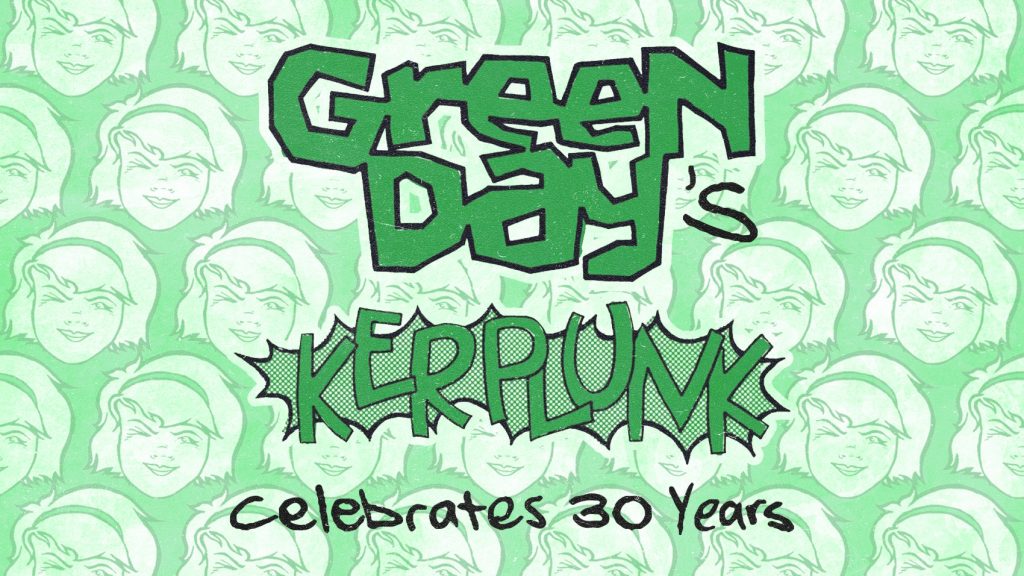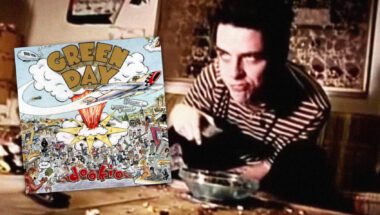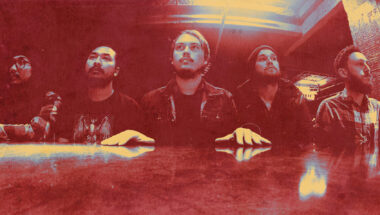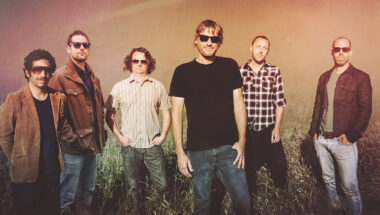In 1991, international pop punk superstars Green Day hadn’t yet achieved international fame. And, while they may have been rising local stars in the East Bay punk scene, they were still a far cry from any major commercial success. All of that would begin to change, though, when the band released Kerplunk—often stylized as Kerplunk!—their sophomore LP on Lookout! Records on December 17, 1991.
While it isn’t one of Green Day’s top sellers, Kerplunk! marked the end of the band’s era as indie stars, and the beginning of their transition to commercial celebrities. With 10,000 copies sold on its release day, Kerplunk! remains one of the best-selling albums ever released from an independent label, and would go on to sell more than a million copies in the U.S. and over four million copies worldwide.
The album has a few notable achievements other than its numbers alone. Kerplunk! is the first studio recording in the band’s discography that features drummer Tré Cool, as well as the original recording of “Welcome to Paradise,” which would be re-recorded as the fifth track on the band’s major label debut, Dookie. The record’s 12 pop punk songs are accompanied by goofy liner notes and iconic, yet simple, artwork — the cover image of a winking woman brandishing a gun and the smiling cartoon flower on her t-shirt have both been tattooed on Green Day superfans all over the world.
One of the inserts included in Kerplunk! was a fictitious diary entry from “Laurie L,” a teenage brat who murdered her parents so she could go on tour with Green Day. As the story goes, Laurie is arrested backstage and sentenced to time in prison until 2019. The author of this insert is none other than Larry Livermore, the principal owner and co-founder of Lookout! Records, which released Green Day’s earliest studio recordings.
To celebrate 30 years of Kerplunk!, Riot Fest chatted with Livermore about his time at Lookout! and his role in releasing Kerplunk! — including how his quirky submission for a local fanzine and bare bones idea for an album cover actually spoke about the looming issues of misogyny and sexism in punk rock.
As the principal owner of Lookout! Records, what involvement did you have in Kerplunk!?
I was mainly responsible for the album cover. I did not have that much influence or impact at all on the music. Green Day were always a band that just did things their own way. And unlike a lot of bands who would ask me for advice, like if they should put backups on their chorus, things like that, Green Day just knew what they were going to do. The only real effect I had on the production of the album in terms of the audio was that I pushed the band to get into the studio in the spring of 1991, because it had been a year since their first album [1,039/Smoothed Out Slappy Hours]. So I booked them into the studio and said, “Go! Get started on the new album.” They went, but I didn’t realize that they weren’t completely thrilled about it. Still, they turned out a six-song demo that was unusually…not that great for them. Normally, anything they did was just awesome, right from the start. But the six-song demo was just okay. It was as good as most of the other stuff Lookout! was putting out at the time, but it wasn’t up to their top quality.
It turned out those six songs were all the songs they had, so we put everything on hold and I said to let me know when they were ready to do the whole album. About six months later, they went to the studio and a couple days later—I mean, literally a couple days, that’s how fast they worked—they brought me a tape, and that was that. I don’t think I even heard the whole thing until I went down to Los Angeles to master it.
I didn’t realize you mastered audio for Lookout!
I wasn’t an expert at the time. I’m not an expert now. But I learned a lot from working on mastering those early songs. The guy who did all of our mastering [John Golden] had been in the business since the 60s and had worked with every kind of artist imaginable. He taught me a lot, but basically we would play the songs back on two giant speakers, and then on little speakers, and then car stereo speakers and tweak it. But there wasn’t that much to do when you’ve got a band like Green Day—they know what they’re doing.
Tim Armstrong said this about Operation Ivy once: You can tell Operation Ivy, but you can’t tell ‘em much, and Green Day was in that same ballpark. I mean that in a good way. If you’re an artist, it’s good to know what you’re doing. It’s also good to listen to other people’s opinions. But don’t be overly swayed.
So you didn’t have much involvement with the songs on Kerplunk!, but it’s a different story when it comes to the visual art and liner notes, right?
Oh, yes. As good as they were in the studio, Green Day were not so great with cover art. In fact, that seemed to be the case with a lot of our best musicians. They said, “Whatever, yeah, sure, we’ll get something together,” and then it would never happen. That was the case with the first Green Day album—we had to throw something together at the last minute. This time, I said to just let me take care of it. So I came up with the concept of the girl with the smoking gun. I had some collaboration with the art on the back, especially with the dead punk, who’s actually modeled after a kid we knew. I can come up with ideas and relay them to an artist, but I can’t draw at all. I went to Chris Appelgren, one of my main co-conspirators at Lookout!, and told him what I was envisioning. He drew it, but it wasn’t quite right yet, so he drew it again, and everybody said, “Yeah, that looks cool, but she looks too much like Chris’s girlfriend,” which she did. The third time he drew it, that’s the cover that became famous and is now on a whole lot of t-shirts.
The dead punk on the back is a kid named Josh, who worked at the copy shop where we got a lot of our late-night copies done for flyers and seven-inch covers and stuff. It looks just like him. He later sang in a band called Black Fork, which was another Lookout! band.
Where did the inspiration for the girl with the gun on the cover come from?
The whole idea for the album cover actually came out of the story that’s on the inside of the album, “My Adventure with Green Day by Laurie L.” And that story was influenced by this mentality that was happening in the punk scene in the early 90’s. At that time, Green Day were starting to get a little bit popular. A lot of the punks were making fun of them and picking on them because girls, especially young high school girls, (as if that’s something terrible) had started coming up to the front and dancing and loving the band. The mean punk boys decided that Green Day weren’t punk anymore, and they couldn’t like them.
The cover art was a way of saying punk girls are here, and they’re playing their part now. I wrote the story of Laurie L. to mock that whole mindset. It was originally published in a fanzine called Tales of Blargh, published by a punk named Janelle, who was only in her mid-teens at that time. She first showed up at 924 Gilman [the DIY venue where Green Day played many of their early local shows] when she was 12. She was cool and tough and definitely not your average teenybopper. She’s partly responsible for inspiring that story, both by being a cool girl but also by asking me to do that story, which I just kind of tossed off in an afternoon.
There always has been—and still is—a big macho streak to punk rock. All through the earlier 80s, punk had been basically a male-dominated, macho thing, and young women, for the most part, stayed out of the pit because they didn’t want to get clobbered or manhandled. Gilman changed that. Even though Gilman was a very happy-go-lucky and easygoing place compared to most punk venues, there was a feel of having to be grim and serious to really be punk—God forbid somebody should catch you smiling or having fun. I think women are more discerning, and when they start saying, “Hey, I like this artist,” that’s probably a good sign that they’re on their way. A male fan might see that and say, “Oh my God, there’s girls here, I better get out of the pit.” It was a weird thing, but to me, it shows that many guys in the punk scene were showing a lot of disrespect to their fellow Green Day fans, just because they happened to be young girls.
My whole point in writing that story and doing that cover with a strong woman was that you can’t not take girls seriously, because they can be just as big of fans, and they can also mess you up. Not that I was encouraging young Green Day fans to get pistols and shoot punk boys of course, but the message is there symbolically. The gun in the girl’s hand on the cover of Kerplunk! is really aimed at macho sexism, not at any individual punk boy. Lookout! was about that all along.
What did Green Day think of the story insert once the album was released?
For a long time, I thought they were indifferent about it. It was a year or two later before I found out that they weren’t that happy about it at all. I said, “Well, you didn’t tell me not to put it in there,” and they said, “Well, you didn’t ask us.” They asked me to take care of the artwork and the cover and I did, so I said, “Just give it some time, you’ll come to appreciate it.” I’m not sure that the contents bothered them, as that it kind of helped further the image of them as teen idol pop stars, which was starting to get to them because they were getting picked on a lot at Gilman about being cute, squeaky clean, little pop idols. They were getting to the point when they would have been about 20 years old, and I think they wanted to see themselves and their music taken a little more seriously. But that’s just my guess.
To be fair, it’s been many years since they complained about it, so I guess they got over it. I’m guessing it was probably after the first million records sold that they got over it. The story of Laurie L was the best selling piece of writing I ever did, actually. I’m pretty sure nothing else I wrote sold a million copies.
In your story, Laurie L. murders her parents so she can go on tour with Green Day. Nowadays, it seems a story like that would never be able to accompany a successful record.
Oh jeez, I would probably not be able to show my face in public again if that came out today. Yeah, it was a different world then, it really was. It was like watching cartoons, like the Road Runner and Wile E. Coyote. Nobody really thought somebody was going to drop an anvil on anybody else’s head. And nobody really thought a girl was going to kill her parents to see Green Day. But yeah, a lot of stuff has happened since then, sadly, that has made that probably not quite as funny as it once was.
Laurie was also supposed to get out of prison in 2019, assuming she made parole. Have you thought of your character in recent years, how she might be doing?
It’s funny you asked that, because there is a girl in Mexico who adopted the name Laurie Livermore a long time ago, back in the early days of Facebook. I’ve never met her in real life, but we’ve exchanged messages over the years. On pretty much the exact date in 2019, she put on Facebook, “Hey, I’m outta jail. Can you come pick me up?” It’s kind of cool seeing your characters come to life.
What was the overall impact of Kerplunk!—on Green Day, the label, or even yourself?
Funnily enough, Billie Joe called a few weeks ago to ask if I was writing anything about the 30th anniversary of the album. I was surprised. That’s not for a long time, I thought. And he said, “Dude, it’s next month in December!” For some reason, I’ve always thought the album came out in February. But he laid out the details of exactly how the record came out, and how I showed up in England right before Christmas and somehow managed to sneak 300 copies of Kerplunk! into the country.
One important thing about the album is, in some ways, it’s the first Green Day album. Although 1,039/Smoothed Out Slappy Hours is one of my favorites until American Idiot, I think the main thing to remember is that Kerplunk! was the first album with Tré Cool. It was almost like a new band the first time I saw Tré play with them—it hardly felt like the Green Day I knew. It’s all the same songs, but it’s blasted off into another dimension. Their first drummer [John Kiffmeyer] was a really good guy and helped make the band happen, and he was a good, competent drummer. But Tré is like a force from beyond the galaxy. I played in a band with him for five and a half years when he was just a kid, so I watched him grow as a drummer. By the time he joined Green Day, he was already becoming one of the best drummers—and if he was here right now, he’d say “One of!?”
The thing about Kerplunk! Is that in a way, it’s not quite as endearing to me, even though it has such great songs and meant a huge amount to me in my life at that time. 39/Smooth has a little bit more amateurishness. It’s kind of cuddly and lovable, like when you tell a little kid, “Wow, that’s really good!” but in a way where you still recognize that they’re a child. With Kerplunk!, they were not kids anymore, even though on the calendar they were only 19 or so. It felt like they had gotten into a spaceship and we’re leaving, going to places where the rest of us couldn’t follow except from afar.



